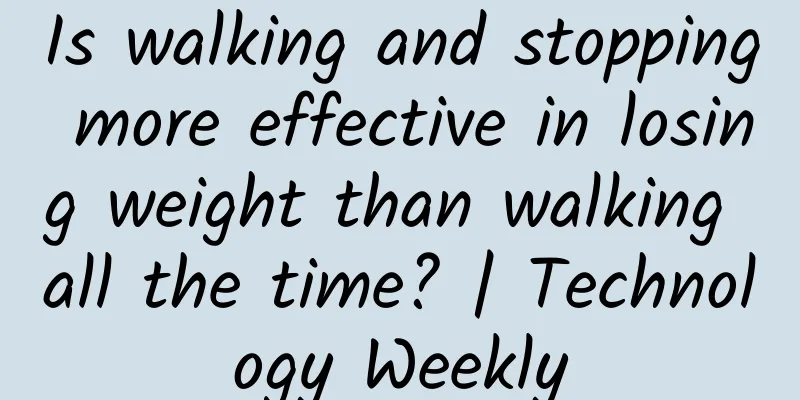Is walking and stopping more effective in losing weight than walking all the time? | Technology Weekly

|
Compiled by Zhou Shuyi and Wang Xiang Ten years after publishing their first paper, nearly half of scholars have retired A longitudinal cohort study of nearly 400,000 scholars from 38 countries found that five years after publishing their first paper, about one-third of scholars quit academia and stopped doing scientific research. This proportion rose to nearly 50% ten years later. In addition, the study found that women are more likely to quit than men, but the difference varies by discipline. The relevant paper was recently published in Higher Education. In the new study, researchers used data from the citation database Scopus to track the publication of nearly 400,000 scholars from the United States, Japan, South Korea, and European countries, covering 16 STEMM (science, technology, engineering, mathematics, and medicine) disciplines. The subjects were divided into two groups, one group published its first paper in 2000, including 142,776 people, of which 52,115 were women; the other group published its first paper in 2010, including 232,843 people, of which 97,145 were women. The analysis shows that among the "2000" group, about one-third of researchers stopped publishing papers five years after their first paper was published. This proportion rose to nearly 50% after 10 years and nearly two-thirds after 19 years. The probability of women giving up scientific research in the five, ten, and nineteen years period was 12.54%, 11.52%, and 6.33% higher than that of men, respectively. By 2019, only 29.4% of female scholars were still publishing papers, while the proportion of male scholars in the same period was 33.6%. Of the 140,000 researchers who started out in the early 2000s, less than half were still active 15 years later. | Nature News Data from the "2010" group show that the gender gap has narrowed over the past 10 years. Nine years after publishing their first paper, about 41% of female and 42% of male scholars are still active in academia. In addition, the situation varies in different subject areas, and the gender gap is smaller in "math-intensive" subjects such as physics, mathematics, engineering and computer science. For example, in the field of physics, the dropout rate of female scholars after 10 years is about 48%, which is not much different from the 47% for men. The authors of the paper pointed out that these disciplines are underrepresented in women and there is an obvious gender selection effect. Women who can successfully publish papers tend to be more likely to "survive". But in other fields, especially in life sciences, the gender gap is obvious: the dropout rate of female scholars in the field of biology is 58% after 10 years, while that of men is 49%. Stop-and-go walking is more effective for weight loss than walking all the time Perseverance is a good thing, but you may not need to maintain a constant running speed during exercise. A study published in Proceedings of the Royal Society B on October 16 showed that stopping and starting while climbing stairs or taking a walk can burn 20% to 60% more calories than doing the same activity continuously, and the exercise effect is better. Image credit: Pixabay/CC0 Public Domain The researchers recruited 10 volunteers and asked them to walk (1.39 m/s) or climb stairs (0.20 m/s, 0.25 m/s, 0.36 m/s) at different speeds for durations ranging from 10 seconds to 4 minutes. The researchers asked the volunteers to wear breathing masks to monitor their oxygen intake during the process and estimate calorie consumption based on this. The results showed that multiple stop-and-go walks consume 20% to 60% more calories than continuous walking over the same distance. At the beginning of each walk, more calories are needed to warm up and "start", and after walking for a period of time, the body enters a metabolic steady-state, in which the heart rate is stable, the production and consumption of energy in the body are balanced, and the exercise efficiency is higher. Francesco Luciano, an author of the paper and a researcher at the University of Milan in Italy, said: "When we stop and go, we consume more calories and oxygen to walk the same distance. It's like a car, 'starting' consumes more fuel than 'cruising'." The study further supports the idea that short walks and stair climbing are good for health, and in particular, may explain why even long periods of sedentary behavior can produce good results with short bursts of exercise. The new research will also help develop rehabilitation programs for people with limited mobility who have difficulty exercising for long periods of time, such as obese patients or stroke patients. A large number of new RNA viruses have been discovered with the help of AI A study published in Cell on October 9 reported the discovery of 180 supergroups and more than 160,000 species of RNA viruses worldwide, greatly expanding the diversity of RNA viruses worldwide. The study applied artificial intelligence technology to virus identification, discovered the "dark matter" of viruses that traditional research methods could not find, and explored new paths for virology research. At first, people confirmed the existence of viruses by isolating and culturing them and observing them under a microscope. With the development of biogenomics, scientists can use sequencing technology to compare the similarities between nucleic acid sequences of unknown viruses and known viruses to identify and characterize new viruses. This method relies heavily on existing knowledge of viruses. However, RNA viruses are highly differentiated, diverse, and easily mutated. This method of sequence homology comparison can easily fail, especially when faced with "dark matter viruses" that lack homology or have very low homology. In this study, the core algorithm used by the team, LucaProt, is a Transformer model capable of deep learning. After learning a large number of viral and non-viral genome sequences, it can independently form a set of judgment criteria for viruses, thereby mining viral sequences in a large number of RNA sequencing data sets. In the test, LucaProt showed extremely high accuracy and specificity, with a false positive rate of 0.014% and a false negative rate of 1.72%. In comparison with other virus mining tools, it also shows advantages in processing longer sequences. The LucaProt model has been open sourced in the paper. Using artificial intelligence to deeply explore and classify the global viral circle | Sun Yat-sen University Using this algorithm, the research team conducted virus mining on 10,487 RNA sequencing data from biological environmental samples around the world, and discovered more than 510,000 viral genomes, representing more than 160,000 potential virus species and 180 RNA virus supergroups (equivalent to the classification level of phylum or class), which increased the number of RNA virus supergroups by about 9 times. Among them, 23 supergroups could not be identified by sequence homology methods. Professor Shi Mang, author of the paper and a professor at the School of Medicine of Sun Yat-sen University, said: "Artificial intelligence algorithm models can discover viruses that we have previously overlooked or did not know about. This ability is particularly important in disease prevention and control and the rapid identification of new pathogens. Especially during an epidemic outbreak, the speed and accuracy of artificial intelligence can help scientists identify potential pathogens more quickly." Through further analysis, the team reported the longest RNA virus genome to date, with a length of 47,250 nucleotides, and discovered a genome structure beyond previous cognition, showing the flexibility of RNA virus genome evolution. At the same time, the team also identified a variety of viral functional proteins, especially those related to bacteria, further indicating that there are more types of RNA bacteriophages waiting to be explored. Shi Mang said that the study showed the depth of virus diversity, but the breadth still needs to be supplemented by more samples. The diversity of viruses is far beyond human imagination, and what we have seen so far is still the "tip of the iceberg." He hopes to continue to make full use of the advantages of cloud computing and artificial intelligence through cross-disciplinary scientific research cooperation in the future to solve important problems in the field of life sciences. Standing does not offset the risks of sitting, but is harmful to the circulatory system "Sitting for a long time is harmful to health" has been proven by more and more studies and has become a popular concept. "Standing office" came into being and is seen as an effective way to combat the harm of sitting for a long time, and is favored by many people. But a new study shows that this effort may be in vain - in the long run, replacing "sitting for a long time" with "standing for a long time" will not improve cardiovascular health, but may lead to circulatory system problems such as varicose veins and deep vein thrombosis. The relevant paper was published in the International Journal of Epidemiology on October 16. The researchers used data from the UK Biobank to include 83,013 adults (average age 61.3 years, 55.6% women), and used wearable accelerometers to assess their sitting and standing time over a 7-day period. The participants' health was tracked over an average follow-up of 6.9 years. The results showed that during the follow-up period, a total of 6,829 cases of cardiovascular disease (coronary heart disease, heart failure, and stroke) and 2,042 cases of orthostatic circulatory diseases (orthostatic hypotension, varicose veins, chronic venous insufficiency, and venous ulcers) occurred. The study used Cox regression models and restricted cubic splines (RCS) to assess hazard ratios (HR), and explained competing risks using the Fine-Gray test. The analysis shows that the length of standing time is not related to the risk of cardiovascular disease, but standing for more than 2 hours a day on average is associated with an increased risk of orthostatic circulatory disease; sitting for more than 10 hours a day on average is associated with an increased risk of both orthostatic circulatory disease and cardiovascular disease; maintaining a static state (including sitting and standing for a long time) for a long time is harmful to health, which is mainly caused by sitting for a long time. "The key is that standing for a long time will not offset the harm caused by sitting for a long time, but will damage the health of the circulatory system." Matthew Ahmadi, the author of the paper, said, "For people who sit for a long time, regular exercise and moving from time to time may be a better way to reduce the risk of cardiovascular disease." Ahmadi's previous study showed that even for people who sit for more than 11 hours a day, 6 minutes of vigorous exercise or 30 minutes of moderate-intensity exercise a day can significantly reduce the risk of cardiovascular disease. Playing football may help prisoners reform Playing football may help prisoners improve their behavior in prison and reintegrate into society after being released, according to a paper published in Nature Human Behavior on October 14. The findings provide new insights into how to reduce recidivism rates. A program called Project Twinning organizes football-based activities for inmates, aiming to improve their physical and mental health. The program was started in the United Kingdom, but has also been implemented in the United States, Italy, Australia and South Africa. Project Twinning seeks to help prisoners gain skills, such as relationship building and self-control, to transition back into society after release. The program pairs prisons with local football clubs, including Liverpool, Manchester United and Chelsea in the United Kingdom. But it is unclear whether the program improves inmates' behavior while they're in prison, reduces crime rates after release, or increases employment opportunities for ex-offenders. To investigate the effectiveness of the pairing program, Martha Newson and colleagues at the University of Oxford in the UK analyzed the behavior of inmates in 45 British prisons. They compared the performance of 676 participants in the program with 1,874 non-participants and found that participating in the program generally reduced prisoners' violations and improved their performance overall. The researchers also surveyed 1,797 employers to understand what factors would affect their willingness to hire ex-offenders. The researchers found that people were more willing to hire ex-offenders who had completed educational programs such as the "pairing program." These findings suggest that football may provide an opportunity to foster social connections, help rehabilitate and support prisoners' reintegration into society. However, the authors note that the success of this program may depend on the attitudes of the prisoners. (China Science Daily) Cats can pair human language with images German philosopher Cassirer pointed out in "An Essay on Man" that from the perspective of human culture, "symbolic thinking and symbolic behavior are the most representative characteristics of human life", and humans can be defined as symbolic animals. Saussure, the founder of modern linguistics, believed that language is a symbol system. Indeed, when we pronounce a name, the fleeting sound waves are meant to be combed into a web of the experiential world, and imagination and hope unfold. A new study shows that cats also have this ability to match language with things - they can match images with human language without special prompts or rewards. Cats may care more about what we say than humans think. In the new study, 31 adult cats were given a word test designed for human babies: the researchers showed the cats two cartoon animations in a loop while repeatedly playing meaningless audio of fictional words - one animation was accompanied by "keraru" and the other was accompanied by "parumo" until they got bored and looked away. After a short break, the cats came to the computer screen again to watch the animations - except that this time some of the animations were accompanied by opposite word audio. After hearing the "wrong" words, the cats seemed confused: they spent an average of 33% more time staring at the screen, and some cats even showed signs of dilated pupils. The study believes this shows that they have associated the words with the images. Experimental diagram | Scientific Reports Surprisingly, most cats learned the association after only two rounds of viewing (each round of the word was repeated four times and the animation was shown for nine seconds), while 14-month-old human babies needed four rounds (each round of the word was played seven times and the animation was shown for 15 seconds) to learn it. However, experts said that the results of the study do not necessarily mean that human babies learn words slower than cats. There are differences in the testing methods between the two. For example, cats heard three-syllable words spoken by their owners in exaggerated tones, while babies heard monosyllable words spoken by unfamiliar voices in various tones. Although the new findings cannot be directly compared with those of other animal studies, cats are indeed able to associate words they hear from humans with objects around them—even without any reward-based training, just as human infants learn language, the researchers said. Special Tips 1. Go to the "Featured Column" at the bottom of the menu of the "Fanpu" WeChat public account to read a series of popular science articles on different topics. 2. Fanpu provides a function to search articles by month. Follow the official account and reply with the four-digit year + month, such as "1903", to get the article index for March 2019, and so on. Copyright statement: Personal forwarding is welcome. Any form of media or organization is not allowed to reprint or excerpt without authorization. For reprint authorization, please contact the backstage of the "Fanpu" WeChat public account. |
>>: Iodized salt, non-iodized salt, low-sodium salt...which one is more suitable for your family?
Recommend
Tips and strategies for placing Weibo Fans Advertising!
The eyewear industry has reached a historical jun...
Tutorial on how to edit mobile videos (Jianying) from scratch, a must-have skill in the era of short videos
Most of those who make short videos in self-media...
Equity Incentive and Equity Financing Solutions Class
Resource introduction of equity incentive and equ...
New car B2B platform "Niuniu Auto" received 110 million yuan in Series B financing led by Kaitai Capital
It is understood that Niu Niu Auto is a leading do...
Four ways to update UI asynchronously on Android
As we all know, due to performance requirements, ...
User Operations | Analyzing Common Patterns of User Operations
In the Internet age, whoever wins the users wins ...
LG's four new smartphones all run Android Lollipop
LG announced yesterday that it will launch four m...
Congratulations! Achieved many firsts
The Shenzhou 15 astronaut crew recently used the ...
"Who says only those standing in the light are heroes?" Approaching the "underground dragon" - China's giant shield aircraft
When it comes to major national weapons What can ...
How do roosters know the time and why do they crow on time every day?
Apart from the barking of dogs and cats, the crow...
How important is it to hold on to "Chinese seeds" to our country's food security?
Seeds are the "chips" of agriculture, a...
Rocket launches fail for different reasons
In 2022, there were 186 orbital launches worldwid...
A small capsule that can sense your heartbeat at all times!
Author: Shi Xiangqi and Li Chuanfu With the rapid...
What is the result of the Russian "troll army" spending $100,000 on Facebook advertising?
On September 20, local time, Facebook Chief Secur...









